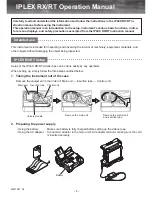
Functional Safety Manual
for the Memosens transmitter Liquiline M CM42 SIL
Version:
Page:
2.0
4
of
72
A
ll
e
R
ec
h
te
v
o
rb
eh
al
te
n
.
D
as
K
o
p
ie
re
n
d
ie
se
s
D
o
k
u
m
en
ts
u
n
d
d
ie
V
er
w
en
d
u
n
g
v
o
n
T
ei
le
n
au
s
d
ie
se
m
D
o
k
u
m
en
t
is
t
o
h
n
e
sc
h
ri
ft
li
ch
e
G
en
eh
m
ig
u
n
g
d
er
E
n
d
re
ss
+
H
au
se
r
C
o
n
d
u
ct
a
G
m
b
H
+
C
o
.
K
G
n
ic
h
t
er
la
u
b
t.
A
ll
ri
gh
ts
re
se
rv
ed
.
P
as
si
n
g
o
n
an
d
co
p
yi
n
g
o
f
th
is
d
o
cu
m
en
t,
u
se
an
d
co
m
m
u
n
ic
at
io
n
o
f
it
s
co
n
te
n
ts
n
o
t
p
er
m
it
te
d
w
it
h
o
u
t
w
ri
tt
en
au
th
o
ri
za
ti
o
n
fr
o
m
E
n
d
re
ss
+
H
au
se
r
C
o
n
d
u
ct
a
G
m
b
H
+
C
o
.
K
G
.
TABLE OF CONTENTS
1
Structure of measuring system using a CM42 SIL transmitter
6
1.1
System Components
6
1.2
Description of the application as a safety related system
7
1.3
Valid device types
9
1.4
Applicable device documentation
10
2
Description of safety requirements and boundary conditions 10
2.1
Safety Function (SAF) – SIL measuring mode
10
2.1.1
Safety Function 1 (SAF1) – limit value monitoring
11
2.1.2
Safety Function 2 (SAF2) – safe measurement
13
2.1.3
Precision and Timing of SAF1 and SAF2
13
2.1.4
Safe calibration and adjustment (SAF3 and SAF4)
15
2.2
Safety-related signal and safe state
15
2.3
Restrictions for the use in safety related applications
18
2.4
Behavior of the device when in operation and in case of failure
24
2.4.1
Behavior of the device when switched on
24
2.4.2
Behavior of the device on demand
24
2.4.3
Behavior of the device in the event of alarms and warnings
25
3
Installation
26
3.1
Mounting, wiring and commissioning
26
3.2
Orientation
26
4
Operation
26
4.1
Basics of safety relevant operations
26
4.2
Calibrating the measuring point
26
4.3
Method of device parameterization
27
4.4
Using the SIL mode and the Classic mode – Switch to SIL mode
27
4.5
The SIL mode – Active safe state mode
33





































